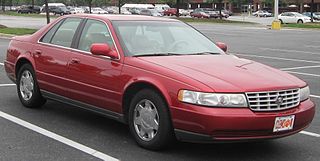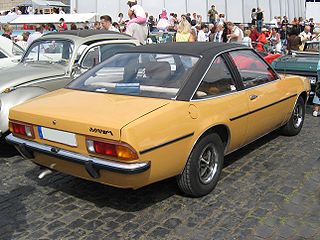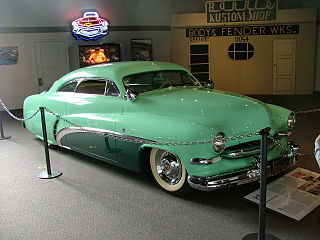
Lincoln Motor Company, or simply Lincoln, is the luxury vehicle division of American automobile manufacturer Ford Motor Company. Marketed among the top luxury vehicle brands in the United States, Lincoln is positioned closely against its General Motors counterpart Cadillac. However, beginning with the 2021 model year, they only offer SUV and Crossover vehicles.

Cadillac Motor Car Division, or simply Cadillac, is a division of the American automobile manufacturer General Motors (GM) that designs and builds luxury vehicles. Its major markets are the United States, Canada and China. Cadillac models are distributed in 34 additional markets worldwide. Historically, Cadillac automobiles were at the top of the luxury field within the United States, but have been outsold by European luxury brands including BMW and Mercedes since the 2000s. In 2019, Cadillac sold 390,458 vehicles worldwide, a record for the brand.

The Continental Mark II is an ultra-luxury coupé that was sold by the Continental Division of Ford for the 1956 and 1957 model years. The first product line of Continental, the Mark II was developed as the worldwide flagship vehicle of Ford Motor Company. Developed as a successor for the 1939–1948 Lincoln Continental, the Mark II derived its nameplate from European manufacturing practice, denoting a second generation of the model family; Ford would later use this nomenclature for the Mark Series of flagship personal luxury cars.

The Continental Mark III is a personal luxury car marketed by Lincoln from the 1969–1971 model years. The namesake successor of the 1956–1957 Continental Mark II, the Mark III likewise served as the flagship vehicle of Ford Motor Company. Offered as a two-door hardtop coupe, the Mark III was noted for its hidden headlights, Continental spare recalling the Mark II and its Rolls-Royce styled grille.

The Cadillac Escalade is a full-size luxury SUV manufactured by General Motors and marketed by their luxury division Cadillac. It was the luxury brand's first major entry into the SUV market. The Escalade was introduced for the 1999 model year in response to an influx of new luxury SUVs in the late 1990s such as the Mercedes-Benz M-Class, Range Rover, Lexus LX, and (especially) Ford's 1998 debut of the Lincoln Navigator. The Escalade project went into production only ten months after it was approved. The Escalade is built in Arlington, Texas. The term "escalade" refers to a siege warfare tactic of scaling defensive walls or ramparts with the aid of ladders or siege towers. More generally, it is a French word which is the noun-equivalent form of the French verb escalader, which means "to climb or scale".

The Cadillac Eldorado is a luxury car manufactured and marketed by Cadillac from 1952 until 2002 over twelve generations.

The Cadillac Seville is a mid-size luxury car manufactured by Cadillac from the 1976 to 2004 model years as a smaller-sized, premium model. It was replaced by the STS in 2004 for the 2005 model year.

Pimp My Ride is an American television series produced by MTV and hosted by rapper Xzibit, which ran for six seasons on MTV from 2004 to 2007. In each episode, a car in poor condition is both restored and customized. The work on the show was done by West Coast Customs until season 5 and was done by Galpin Auto Sports thereafter.

Vinyl roof refers to a vinyl covering for an automobile's top.

The Cadillac Fleetwood is a full-size luxury sedan that was marketed by Cadillac from the 1977 through 1996 model years. Taking its nameplate from a coachbuilder historically associated with the General Motors division, the Cadillac Fleetwood became a stand-alone model line in 1985.

The Cadillac Series 40-62 is a series of cars which was produced by Cadillac from 1940 through 1964. Originally designed to complement the entry level Series 61, it became the Cadillac Series 6200 in 1959, and remained that until it was renamed to Cadillac Calais for the 1965 model year. The Series 62 was also marketed as the Sixty-Two and the Series Sixty-Two. The Series 62 was used to introduce the Cadillac Coupe de Ville and the Cadillac Eldorado which started out as special appearance packages that were later placed into production.

Whitewall tires or white sidewall (WSW) tires are tires having a stripe or entire sidewall of white rubber. These tires were most commonly used from the early 1900s to around the mid 1980s.

A custom car is a passenger vehicle that has been altered to improve its performance, change its aesthetics, or combine both. Some automotive enthusiasts in the United States want to push "styling and performance a step beyond the showroom floor - to truly craft an automobile of one's own." A custom car in British usage, according to Collins English Dictionary, is built to the buyer's own specifications.
A scraper is an informal term to describe a modified American-made luxury/family car, usually a General Motors model from the 1980s to current vehicles, typically enhanced with after-market rims. Scrapers are popular in the San Francisco Bay Area of Northern California, usually associated with the hyphy music and lifestyle movement. An example of hyphy is shown in the E-40 lyrics "sittin' in my scraper watching Oakland gone wild". A scraper is a general description and can refer to a number of different model cars. Popular models include the Buick Regal and LeSabre, Pontiac Bonneville, Buick Century, Oldsmobile Delta 88, Buick Riviera, Buick Reatta, Oldsmobile Cutlass Ciera, Oldsmobile Cutlass Supreme, Pontiac Grand Prix, Lexus SC, Chevrolet Caprice Classic, and Chevrolet Impalas, as well as full size conversion vans such as the GMC Vandura. Supercharged automobiles are particularly sought after due to their high performance.

A continental tire or a continental kit is the common U.S. term for an upright externally-mounted spare tire behind an automobile's trunk.

A Cal looker is any air-cooled Volkswagen modified in fashion originating in Orange County, California in the late 1960s.

Kustoms are modified cars from the 1930s to the early 1960s, done in the customizing styles of that time period. The usage of a "K" for "Kustom" rather than a "C", is believed to have originated with George Barris.

Hi-risers are a type of heavily-customized automobile, typically a full-size, body-on-frame, rear-wheel drive American sedan. They are modified by significantly increasing the vehicle's ground clearance, and adding large-diameter wheels with low-profile tires. Depending on the model, year and bodystyle, cars customized in this style can be labeled "donk", "box" or "bubble". Many within the community refer to this style of car as simply a "big rim" or "big wheel" car.

The Cadillac V-12 is an exclusive V-12 powered luxury car that was manufactured by Cadillac from the 1930 through the 1937. Below only the maker's top-of-the-line Cadillac V-16 line, these were powered by the Cadillac V12 engine, furnished with similar custom bodies, and built in relatively small numbers. A total of 10,903 were made in the seven model years that the automobile was built, with the majority having been constructed in its inaugural year. It was Cadillac's first, and is to date, Cadillac's only standard production V-12 automobile.
Slab is an acronym for "slow, loud, and bangin'" that describes a custom car, music and surrounding culture that's associated with hip-hop culture that emerged in the Houston area.

















